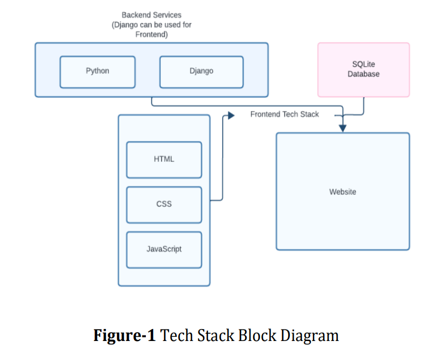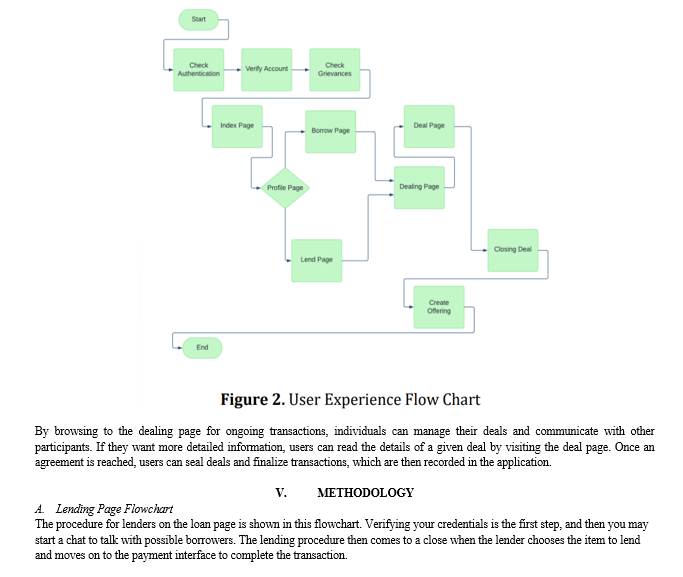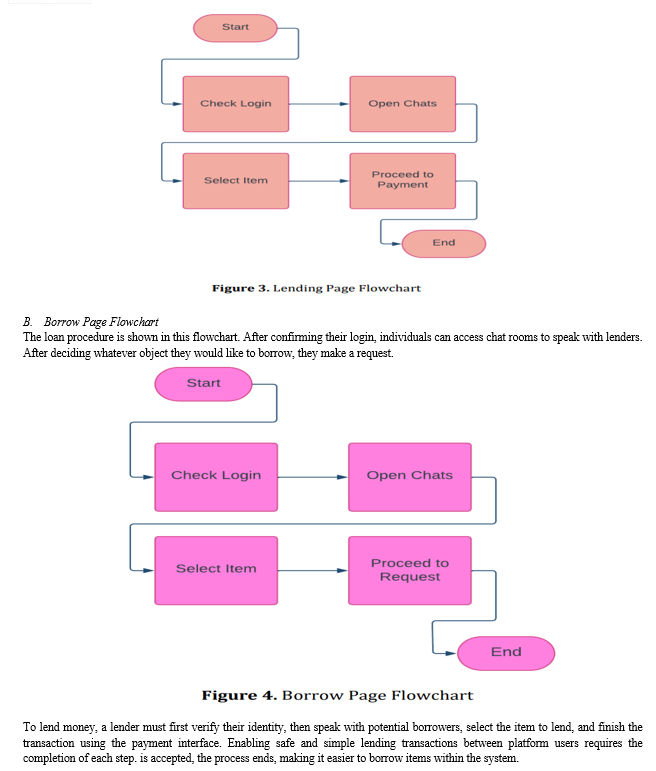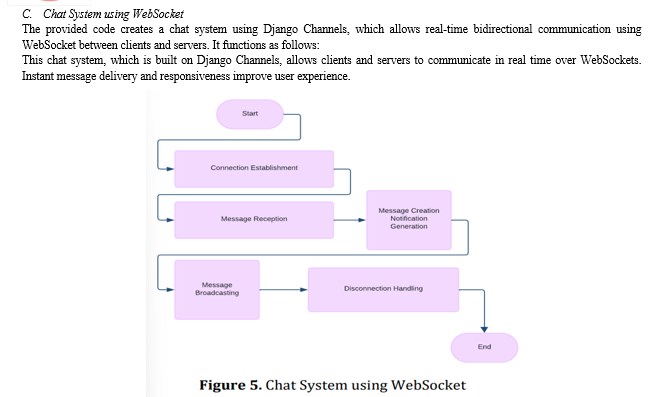Ijraset Journal For Research in Applied Science and Engineering Technology
- Home / Ijraset
- On This Page
- Abstract
- Introduction
- Conclusion
- References
- Copyright
Borrow Barter Bridge - Hostel Necessities Web Platform
Authors: Dr Rishabh Garg, Yash Mehra, Nand Singh, Yash Rathi
DOI Link: https://doi.org/10.22214/ijraset.2024.61087
Certificate: View Certificate
Abstract
We propose the creation of a hostel sharing platform for such necessities in response to the previously described issue of frequent access to necessities in the two aforementioned hostel environments. This platform would fulfill demands ranging from laptops and hair straighteners to belts and kettles, allowing for borrowing and lending of things with a maximum 48-hour return time. In order to begin, each user must first create an account with their personal information, agree to a user policy stating that they are liable for any borrowed stuff, and take pictures of any lent or borrowed objects during the meeting. To penalize offenders, trust points will be awarded for adhering to the policy and banned for breaking it. The number of points taken will increase with each infraction, and offenders will be subject to a justification and fine period after being reinstated. By maximizing resource use and guaranteeing timely meeting of urgent requirements, this platform seeks to promote a culture of accountability and mutual aid while protecting user interests.
Introduction
I. INTRODUCTION
In the hectic environment of living in dorms, students sometimes find it challenging to acquire basics. Unexpected demands can arise for things like a laptop to complete homework on time, a kettle to brew tea late at night, or a belt that was left behind for a formal event. When time, money, or availability constraints prevent them from quickly obtaining these things, students feel frustrated and challenged. To address this ongoing issue, we propose to develop the Hostel Necessity Sharing Platform, a web-based platform. Hostel communities would find it simpler to lend and borrow goods from one another with this platform. The Hostel Necessity Sharing Platform cannot succeed unless robust safety protocols and accountability systems are in place to safeguard the rights of all users. Each student must register for a personal account on the platform, provide their identifying information, and agree to terms and conditions that outline their responsibility for items they borrow. Users must furthermore submit photos of the exchanged items to attest to their condition at the time of lending, ensuring transparency and accountability throughout the borrowing process.
II. LITERATURE REVIEW
The corpus of research on accommodations and management for hostels provides a wide range of studies aimed at enhancing the efficiency, sustainability, and user experience in these kinds of settings. Adetunji et al. (2020) looked into the implementation of a hostel allocation system that went beyond the traditional "first come, first serve" method, emphasizing the need to streamline procedures to meet students' preferences and needs. Kodi (2021), by instituting a hostel reservation system, contributed to this conversation. This approach reduces paperwork while simultaneously making learning easier and more accessible for both administrators and students. Amer (2020) looked studied the sustainability of hostel operations, highlighting shortcomings in meeting environmental standards and suggesting improvements to waste and resource management. Olawuyi (2020) introduced an internet-based online hostel administration system with the goal of improving overall hostel operations efficacy and streamlining administrative tasks. Isinkaye et al. (2022) created a chatbot system for hostel placement and suggestion that is mobile-based to assist students in finding suitable housing options. In addition to technical advancements, Vosloo (2020) provided a critical examination of South Africa's migrant labor hostel system, shedding light on the social and historical elements influencing hostel dynamics. Furthermore, Achine and Charles (2023) evaluated student dorm fire safety measures, emphasizing the value of robust safety protocols and infrastructure to lower risks. Hamid et al. (Year) provided a sustainable approach for college residence halls, stressing the value of effective resource management. Subair and Adeniyi (2021) underlined the need of infrastructure development in their assessment of the hostel facilities at Nigerian institutions in order to meet the growing demands of the student population. Pendke et al. (2021) introduced an instantaneous method for searching for food and shelter in response to the changing needs of urban populations seeking quickly accessible and comfortable living options.
When considered collectively, these studies contribute to a comprehensive understanding of hostel management that considers environmental, technological, safety, and accessibility aspects. Consequently, significant insights that will enable policymakers, administrators, and researchers to optimize the dorm experience for students worldwide can be obtained.
III. TECHNICAL STACK DESCRIPTION
A. Python
High-level and versatile, Python is renowned for its ease of use and readability. It features large libraries for a wide range of applications, supports several paradigms, and speeds up development.
B. Django Framework
High-level Python web framework Django encourages efficient development and simple, straightforward design. In addition to having scalability choices and built-in security safeguards, it stresses the DRY (Don't Repeat Yourself) principles.

C. SQLite
Database SQLite is a self-contained relational database engine that is lightweight and serverless. It is frequently utilized in embedded systems, mobile apps, and small-scale applications, requires minimal setting, and supports ACID transactions.
D. Hypertext Markup Language (HTML)
The common markup language used to create online pages and applications is called HTML (Hypertext Markup Language). It uses tags and attributes to specify the content and structure of web documents. 3.5 Cascading Style Sheets (CSS) A stylesheet language called CSS (Cascading Style Sheets) is used to manage how HTML content are presented and laid out. It specifies web element styles, including fonts, colors, and placement.
E. JavaScript
A high-level, interpreted programming language called JavaScript is used to give web pages dynamic behavior and interactivity. It has the ability to work with web APIs, handle events, and modify HTML text.
IV. USER FLOW OF WEBSITE
The start screen greets visitors at the application's initial entrance point, marking the beginning of their user journey. The program then determines whether the user has already been authenticated. The user moves on to the primary functionality if they are logged in. In the event that the user is not authorized, they are required to either create an account or log in. The application then checks to see if the user's account is active and correctly authenticated after authentication. The process is guided for users in case verification is needed. The application also searches for any unresolved complaints related to the user's account. Users are instructed to address any outstanding issues on their profile page.
When the preliminary checks are complete, users are directed to the index page, where they can decide whether to lend or borrow commodities or services from the community. Based on their choice, the visitor is directed to the relevant lending or borrowing page. Along with interacting with the community, users can browse through the offerings and demands that are currently accessible and submit their own requests.



- Connection Establishment: When a user connects to the chat system, the connect method is triggered. The user is added to the appropriate group, their authentication is validated, and the sender and recipient are identified by the room name they entered.
- Reception of Messages: The offering ID, notification receiver ID, and message content are all retrieved by the server when it receives a message from a client. Next, it creates an asynchronous chat message object and notification object in the database and associates them with the applicable sender, receiver, and offering.
- Handling Disconnections: The disconnect method is triggered when a person logs out of the chat system, eliminating them from the group.
VI. WEBSITE SCALABILITY AND DATABASES
The ability of a system to effectively manage growth or an increase in burden is known as scalability. In software development, scalability ensures that a system can function and run even when user demand grows. Enhancing current resources is known as vertical scalability, while adding new resources—such as servers— to split the workload is known as horizontal scalability. This project is highly scalable for number of users connecting on the websites.
Mobile apps, embedded systems, and small-scale applications commonly use SQLite, a lightweight, serverless relational database engine. It takes little administration or setup and is easy to incorporate into projects. SQLite supports standard SQL syntax, transactions, and ACID characteristics, ensuring data integrity and reliability. However, due to its file-based, single-user architecture and absence of a client-server interface, SQLite may not be suitable for large-scale or high-concurrency uses. It works effectively in scenarios where portability, user-friendliness, and low resource consumption are essential.
VII. RESULTS
A projected hostel necessity sharing platform called Borrow Barter Bridge (B3) web based platform.Thanks to the construction of this web-based platform, students will have access to a system where they may lend and borrow various items inside their hostel communities, like computers and kettles, with a maximum 48-hour return time.
The primary objective is to simplify the lending and borrowing procedure while upholding user protection and accountability, resource optimization, and a culture of mutual aid.
Sturdy accountability frameworks and safety rules are critical elements that ensure the platform's effectiveness. Each user must first register for a personal account, provide identification, and agree to terms and conditions outlining their responsibilities before they can borrow anything. Users are required to provide photographs of the returned goods to attest to their condition during the lending process in order to promote accountability and transparency.
The platform navigation, transaction management, and authentication comprise the website's user flow. Users are given instructions on how to sign in, use the major features, browse offers and requests, handle deals, and finish transactions. Users can engage in instantaneous negotiation and communication by chatting with one other in real time over a WebSocket-based chat system.
Conclusion
In conclusion, the Borrow Barter Bridge (B3) initiative provides a solution to the ongoing issue of students residing in dorms being unable to acquire necessities. The project intends to facilitate lending and borrowing within hostel communities by creating a Hostel Necessity Sharing Platform. In order to demonstrate transparency, users must register on the platform, agree to the terms of service, and submit pictures of the traded products. The technological implementation makes use of Python, Django, SQLite, HTML, CSS, and JavaScript to provide a dependable and efficient system. The user flow includes authentication, transaction management, and platform navigation. Moreover, real-time communication between users is possible with a WebSocket-based chat system.
References
[1] Adetunji, O.O., Akintunde, O.J., et al. (2020). Hostel Allocation System: Beyond the First Come First Serve Technique. (Point 1, Para 1) [2] Kodi, E.A. (2021). HOSTEL BOOKING SYSTEM. Academia.edu (Point 1, Para 2) [3] Amer, T. (2020). Evaluating practices of university student hostels towards meeting the requirements of sustainable development. Journal of the Faculty of Tourism and Hotels. (Point 2, Para 1) [4] Olawuyi, V.A. (2020). AN ONLINE HOSTEL MANAGEMENT SYSTEM. ir.mtu.edu.ng (Point 2, Para 2) [5] Isinkaye, F.O., AbiodunBabs, I.G., Paul, M.T. (2022). Development of a Mobile-Based Hostel Location and Recommendation Chatbot System. International Journal of Information Technology and Computer. (Point 2, Para 2) [6] Vosloo, C. (2020). Extreme apartheid: the South African system of migrant labour and its hostels. (Point 2, Para 2) [7] Achine, E.I., Charles, M. (2023). EVALUATION OF THE EFFECTIVENESS AND ADEQUACY OF EXISTING FIRE SAFETY MEASURES IN FUTMINNA STUDENTS\'HOSTELS. (Point 2, Para 2) [8] Hamid, H. Ab, Samad, N. Abdul, Khalid, M.F., et al. (Year). University Hostel Waqf: Developing A New Sustainability Model. European. (Point 3.1, Para 1) [9] Subair, S., Adeniyi, A.O. (2021). Assessment of availability, accessibility and adequacy of hostel facilities in Nigerian Universities. Journal of Humanities Social Sciences. (Point 3.1, Para 1) [10] Pendke, K., Wankhede, N., Dhole, M. (2021). Instant Searching System for Housing and Food in a City. Academia.edu (Point 3.2, Para 1) [11] Perdomo Castillo, E.O. (2022). My touristic product: hostel Neverland inn. oldri.ues.edu.sv (Point 4, Para 2) [12] Asbagh, N.B. (2022). Designing a Hostel in the Touristic Complex of Quri-Gol Lake near Tabriz, Iran. (Point 4, Para 2) [13] Eteng, S.U., Zion, M.M. (2022). Water demand among hostel residents in tertiary institutions in Calabar, Cross River State, Nigeria. Journal of Social Sciences and Management. (Point 5, Para 2) [14] Kumar, B., Soni, J., Gayathri, N. (2022). Dormitory Regulatory System Using Artificial Intelligence and IoT. Journal of Science and Information System.(Point 5, Para 1) [15] Kadir, F., Ogunleye, M.B. (2021). Post Occupancy Evaluation of Students\' Satisfaction with Hostel Facilities in Federal Polytechnic Offa, Kwara State, Nigeria. (Point 5, Para 3) [16] Ode, O.M., Okolie, K.C., Ezeokoli, F.O. (2023). AN EXAMINATION OF SOURCES OF INDOOR AIR CONTAMINANTS IN THE STUDENTS\'HOSTEL ROOMS IN NNAMDI AZIKIWE UNIVERSITY, AWKA-ANAMBRA ... Tropical Built. (Point 6, Para 2) [17] Ifeanyi, O.M., Oyedele, O. (2022). A Study of Fire Safety in Hostel Design: Case Study of Nnamdi Azikiwe University, Anambra State, Nigeria. (Point 6, Para 2) [18] Ahmad, R., Shoukat, M. (2023). An Assessment Of Problems Faced By Female Students Residing In Hostel At University Of Agriculture Faisalabad. (Point 6, Para 2) [19] Kenneth, E.C., Chukwunwike, E.C. (2020). Analysis of Challenges in Managing Students\' Hostel Facilities in Nnamdi Azikiwe University, Awka Anambra State, Nigeria. (Point 6, Para 2).
Copyright
Copyright © 2024 Dr Rishabh Garg, Yash Mehra, Nand Singh, Yash Rathi. This is an open access article distributed under the Creative Commons Attribution License, which permits unrestricted use, distribution, and reproduction in any medium, provided the original work is properly cited.

Download Paper
Paper Id : IJRASET61087
Publish Date : 2024-04-26
ISSN : 2321-9653
Publisher Name : IJRASET
DOI Link : Click Here
 Submit Paper Online
Submit Paper Online

